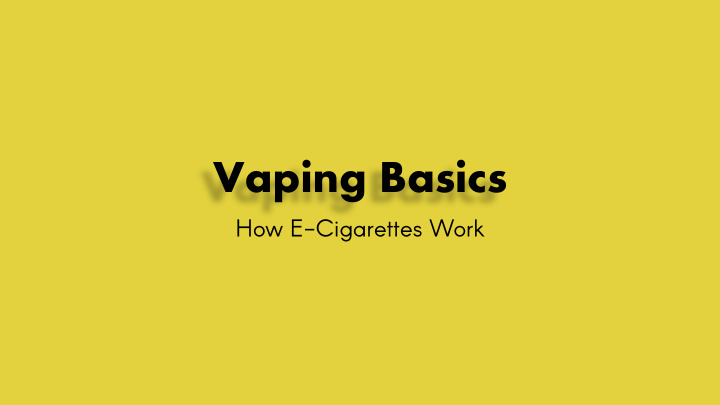



Vaping Basics How E-Cigarettes Work
vaping atomizer vape pen Terms e-cigs electronic nicotine juice delivery system e-hookahs e-liquid
Devices
Some E-Cigarettes Look Like Regular Cigarettes But they have different components that include: • A rechargeable lithium battery, that can be charged with a USB connector. • A cartridge containing nicotine, flavoring and chemicals like glycerin or polyethylene glycol. (Since they are not regulated, they may not list all their ingredients). • An atomizer, which consists of a heating coil. • An LED light to simulate a burning cigarette. • A sensor that registers when you take a drag and activates the atomizer and LED light. Sometimes referred to as first generation products, as the first e-cigarettes on the market look a lot like this.
Vape Pens These e-nicotine devices look more high-tech. They operate in much the same way as first generation e-cigs, but have a refillable chamber for e-liquid and are a bit larger in size. Sometimes referred to as second generation products, because they were the second wave of e-devices. These can be purchased online and in specialty smoke-shops which also carry a wide variety of e-liquids in assorted flavors.
Even More Power These larger vape devices can produce even more vapor than a standard vape pen. You can even purchase room vaporizers. These are third generation products which are also available online and in specialty shops.
How They Work The Heating Coil Connection to Heats the Liquid the battery to Boiling The Bridge Cup The Atomizer The Liquid Then Becomes Vapor An atomizer heats the liquid (often called "e-juice") to its boiling point and that becomes vapor you can inhale. That is why smoking e-cigarettes is often called “vaping.”
The Vapor E-cigarettes produce large clouds of vapor, which have the subtle smell of whatever flavor e-liquid is in it. Since e-cigarettes are not regulated, it’s difficult to know exactly what’s in the vapor every time. However we know it’s more than just water vapor . Some vapor has been proven to have harmful chemicals such as: toluene, acetaldehyde, benzene, cadmium, formaldehyde, isoprene, nickel, lead, and nicotine.
Public Health Concerns Because the product is relatively new, the long-term 89% 9% of E-Cig health effects from the use of e-cigarettes have not been studied. Users are Still E-cigarettes are not regulated and producers are not obligated to disclose the ingredients. Smoking Regular Many tobacco users are seeing e-cigarettes as Cigarettes After a smoking cessation tool. The Food and Drug Administration (FDA) has not approved One Year e-cigarettes as smoking cessation devices.
FOR MORE INFORMATION VISIT www.BangorPublicHealth.org
Recommend
More recommend